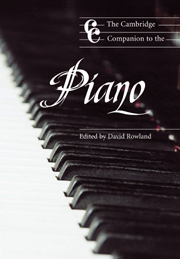Book contents
6 - The acoustics of the piano
from Part one - Pianos and pianists
Published online by Cambridge University Press: 28 September 2011
Summary
Introduction
The underlying acoustical principles of sound production on the piano are very straightforward. When a key is depressed, it causes a small, felt-covered hammer to be thrown against a set of strings tuned to a specific note of the scale. The key incorporates an escapement mechanism which detaches the hammer from the key just before striking the strings so that they receive a single, unimpeded blow from the hammer. The exchange of momentum causes the strings to vibrate, and it is these vibrations which are the origin of the musical sound. The strings do not radiate sound directly, however, because they are much too small to interact with the surrounding air. Instead, they are coupled to a soundboard, a lightweight plate of wood, which is specifically designed to vibrate in sympathy with the strings. It is the structural vibrations of the soundboard which induce pressure changes in the air, rather in the manner of a loudspeaker cone, to create the sound we hear.
This is, of course, just the start of the story. This simple explanation of the mechanical action of the piano invites more questions than it answers. Why do different pianos have different sound qualities? What is the function of double and triple stringing? What control does the performer have on the final sound quality of an instrument? In searching for the answers to these questions, we discover that the piano has a few hidden secrets of surprising complexity, and we have to marvel at the ingenuity of the craftsmen who have played their part in the development of the modern instrument and at the skill of the technician who keeps a piano at the peak of its performance.
- Type
- Chapter
- Information
- The Cambridge Companion to the Piano , pp. 96 - 114Publisher: Cambridge University PressPrint publication year: 1998



